200th Anniversary of RNLI, Part 2 - Tristan Rescue Boats
Issue date: 1st July 2024
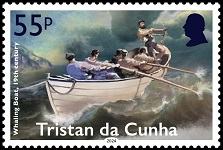 |
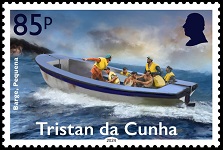 |
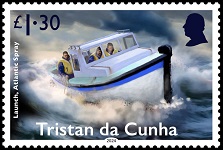 |
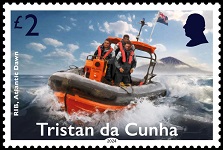 |
| 202405 | Mint Stamps (55p, 85p, £1.30, £2.00) | £4.70 | Shop > |
| 202406 | First Day Cover (with 55p, 85p, £1.30, £2.00 stamps) | £5.90 |
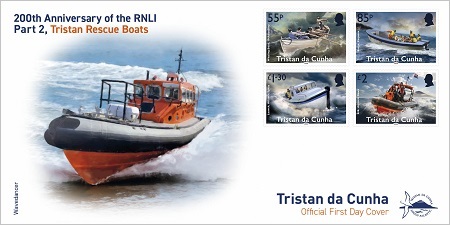
The Royal National Lifeboat Institution (RNLI)
The creation of a service dedicated to the saving of lives at sea was the vision of Sir William Hillary. In the early 19th Century there was an average of 1,800 shipwrecks a year around the coasts of the UK, a risk that was simply accepted as an inevitable part of life at sea.
In 1823 Hillary proposed the creation of a lifeboat service manned by trained crews dedicated to the saving of lives and property from shipwrecks and vessels in distress. When the Admiralty refused to help, Hillary appealed to the philanthropic members of London society. His campaign rapidly gathered momentum resulting in an inaugural public meeting on 4 March 1824 at the City of London Tavern, Bishopsgate. With King George IV granting his patronage the Royal National Institution for the Preservation of Life from Shipwreck was formed. In 1854 the Institution's name was changed to the Royal National Lifeboat Institution, the RNLI, as it is known today.
The story of the RNLI is one of courage and dedication. Since the charity launched its first lifeboat in 1824, the RNLI has saved more than 146,000 lives at sea.
As an Island Nation, Tristan da Cunha is acutely aware of maritime hazards. Tristan has no official Lifeboat service, but the island archipelago has seen many shipwrecks over the years. In fact, many of the first settlers were people saved from a shipwreck. They were so captivated by the island that they stayed and become part of the settlement. The population has repeatedly shown its willingness to aid those in peril on the seas, despite great personal risk.
Tristan has chosen to release two issues to celebrate the 200th Anniversary of the creation of the RNLI. Part 2 depicts various rescue boats used by the RNLI during its history. Part 2 depicts Tristan Rescue Boats that have been used over the years.
Description of the Stamps
55p - Whaling Boat, 19th century - The whaleboat was a double-ended, light, open boat with a length of 27ft - 31ft and a beam of slightly more than ⅕ the length. It was pulled with oars and sailed. These were used by islanders to aid many stricken sailors. Two well-known rescues were of the Blenden Hall and Mabel Clark. The Blenden Hall, drifted onto the rocks at Inaccessible Island, in July 1821. It was not until November 1821 that two boats from Tristan were able to rescue the surviving passengers and crew. In May 1878 the Mabel Clark ran onto a rock off the Molly Gulch, Tristan. The boats and everything on deck were soon washed away, and the ship began to break up. The crew took to the rigging to save themselves. Next day a couple of Tristan whaleboats reached the wreckage and saved the captain's wife, daughter, and crew still on board.
Around 1886 a whaleboat type was adapted by islanders into what is known locally as a longboat.
85p - Barge, Pequena - Built in South Africa the Pequena was bought in by the South African fishing company, Tristan Investments. A 30ft, self- propelled fiberglass and wood barge with a flat hull and 6-cylinder diesel engine. Other barges later used were the Don B and Atlantic Wave. These fiberglass barges were mainly used to offload cargo from fishing and cargo ships that called at the island.
In April 1968 the Pequena was sent out to search for a fishing boat that had not returned to the harbour. Two men were rescued from the water but another was still missing. The fishing boat had sunk and a fisherman was lost. The Pequena and another fishing boat went out again to search for the missing fisherman but he was not found.
The Pequena was sold in 1995 to the Government and renamed Sandy Point Express.
£1.30 - Launch, Atlantic Spray - The Atlantic Spray was built in 1982 by staff at the local fishing factory (Tristan Investments) for the Government using the design of the fishing boats. The Atlantic Spray is a 27ft long fiberglass and wood boat powered by a 4-cylinder diesel engine.
On February 8th, 1986 the Atlantic Spray aided yacht Chricanto that had broken its mast. The family of 5 on-board was bought ashore and over the next few days all of their belongings. On the 10th February Chricanto was towed to the rocky beach and run ashore where she grounded on the rocks and was stripped of all worthwhile materials. The family stayed on Tristan a few months until they could be taken to Cape Town by Tristania II.
£2.00 - RIB, Atlantic Dawn - An 8m tornado search and rescue RIB, the Atlantic Dawn is powered by two Yamaha 200hp outboards. She has a range of 150miles, can carry a max of 10 people and is designed to carry stretchers. The Atlantic Dawn is used for ship to shore operations in poor weather conditions, as a support boat when Islanders go to the Caves, Stoney Beach and Nightingale Island, and has assisted in countless medical emergencies.
On 29th May 2022, MV Duke stopped at Tristan to transfer a sailor who had suffered a stroke. The Atlantic Dawn attended the ship, supported by the Conservation RIB Arctic Tern and rough seas, with waves up to 5 metres high, meant that multiple attempts were necessary. Two and a half hours later the patient was stabilised in the Camogli Healthcare Centre.
Five months later the bulk carrier Penelope I put out an SOS (as they had a sick crew member on board). With Tristan being the closest inhabited land Atlantic Dawn was deployed with the doctor on board. The crew member was safely transferred from the vessel to the island’s Healthcare Centre.
FDC - RIB, Wave Dancer - The Wave Dancer is a Pacific 38 cabin RIB with a range of 200 miles. She is used as a fisheries patrol vessel, fishing and customs inspections, inshore science surveys, and outer-island trips to conduct patrols and support scientific research. The Wave Dancer assists the search and rescue craft during poor weather conditions for operations further offshore.
On 28th January 1999 the Wave Dancer was launched to assist yacht Day Dream, that had dismasted over a month earlier, and had slowly made it to Tristan for help. The skipper’s decision to try to get to Tristan was because "we will be amongst our kind of people who understand. They would be people steeped in the sea and sea history. People who put the saving of life at sea as an issue above everything."
Technical Specifications
| Designer: | Andrew Robinson | Printer: | Cartor |
| Stamp size: | 42 x 28mm | Perforation: | 13¼ x 13½ per 2cms |
| Process: | Stochastic lithography | Sheet Layout: | 10 |
| Production Co-ordination: | Creative Direction (Worldwide) Ltd | ||
